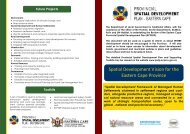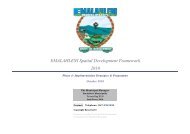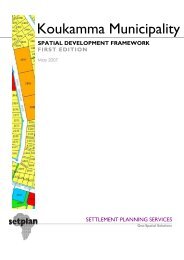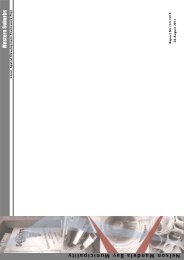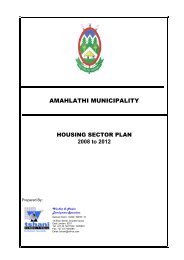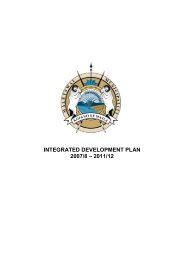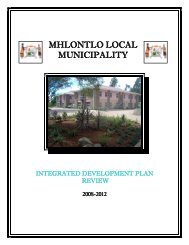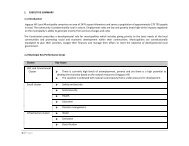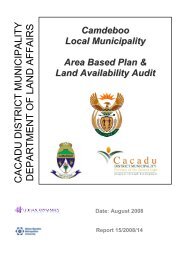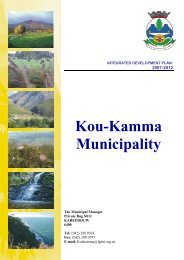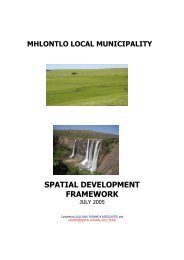intsika yethu local municipality - Provincial Spatial Development plan
intsika yethu local municipality - Provincial Spatial Development plan
intsika yethu local municipality - Provincial Spatial Development plan
You also want an ePaper? Increase the reach of your titles
YUMPU automatically turns print PDFs into web optimized ePapers that Google loves.
The availability of services such as water, energy and transport allow people to become more profitable intheir work, while communication establishes a vital link between people and the outside world. One of theMillennium <strong>Development</strong> Goals (MDG) is to halve the proportion of the population who have nosustainable access to safe drinking water and basic sanitation by 2015.Table 23: Household access to water within IYLMHousehold access to water from 2005-2010ProjectionType of access to water 2005 2006 2007 2008 2009 2010Basic access (In home, 7,819 7,733 7,624 7,996 8,040 8,084yard, or within 200m)Piped water on4,931 4,898 4,846 6,198 6,544 6,890community stand(distance greater than200m from dwelling)Borehole/rain-water 2,440 2,415 2,382 2,644 2,700 2,755tank/wellDam/river/stream/spring 23,206 22,853 22,428 22,130 21,808 21,486Watercarrier/Tanker/Water229 227 224 201 194 186vendorOther/Unspecified 514 509 501 538 545 551Total 39,139 38,636 38,005 39,707 39,830 39,953Source: ECSECC, Statistics Database, 2011.Table 22 presents data regarding IYLM’s resident’s access to water from 2005 to 2009 with the estimatefor 2010 according to ECSECC. The data shows that the majority of IYLM (53%) residents still obtainedtheir water from Dam/river/stream/spring sources in 2010. Only 20% of residents in the area had basicaccess in to water in 2010 (by basic access we refer to households that have access to piped water in theirhomes or on a community stand within 200m from the place of dwelling). The basic access figure hasremained fairly constant since 2005 when 19.97% of residents had basic access to water. The number ofhouseholds using dam/river/stream/spring sources of water has fallen since 2005 when 59.29% of thepopulation used this method to obtain water.It is important to remember that it is the district and not IYLM which bears primary responsibility toensure that people have access to water. In terms of the water supply arrangements in the Intsika Yethuthe district has appointed rural water scheme maintenance contractor – Maluti GSM – to operate andmaintain rural schemes while the DM provides on its own in the town areas of Cofimvaba and Tsomo.Table 24: Household access to energy within IYLMHousehold access to energy 2005-2010ProjectionAccess to energy 2005 2006 2007 2008 2009 2010Solar/other/unspecified 389 393 396 359 351 344Electricity 10,687 10,560 10,391 12,959 13,571 14,184Gas 167 163 158 119 106 92Paraffin 18,063 17,767 17,417 15,907 15,295 14,684Candles 9,833 9,753 9,643 10,363 10,507 10,650Total 39,139 38,636 38,005 39,707 39,830 39,953Source: ECSECC, Statistics Database, 2011.IYLM remains behind much of the province and the rest of the country with regards to electrification.Only 35.50 % of households were estimated to be using electrical energy in 2010. This falls well below thedistrict level of electrified households which was 52.55 for the same period. Paraffin remains the most62



